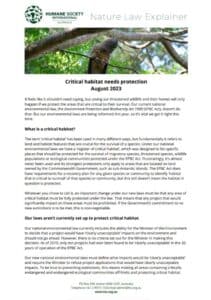One of the most important global meetings on wildlife trade has just wrapped up in Uzbekistan. It’s capital city Samarkand was where governments convened for the 20th Conference of the Parties (CoP20) to the Convention on International Trade in Endangered Species of Wild Fauna and Flora (CITES) to decide how international trade should be managed for some of the world’s most threatened...
Photo Credit: John & Sarah Gilmore – Wildside Sanctuary
It feels like it shouldn’t need saying, but saving our threatened wildlife and their homes will only happen if we protect the areas that are critical to their survival. Our current national environmental law, the Environment Protection and Biodiversity Act 1999 (EPBC Act), doesn’t do that. But our environmental laws are being reformed this year, so it’s vital we get it right this time.
What is a critical habitat?
The term ‘critical habitat’ has been used in many different ways, but fundamentally it refers to land and habitat features that are crucial for the survival of a species. Under our national environmental laws we have a ‘register of critical habitat’, which was designed to list specific places that should be protected for the survival of migratory species, threatened species, wildlife populations or ecological communities protected under the EPBC Act. Frustratingly, it’s almost never been used and its strongest protections only apply to areas that are located on land owned by the Commonwealth Government, such as sub-Antarctic islands. The EPBC Act does have requirements for a recovery plan for any given species or community to identify ‘habitat that is critical to survival’ of that species or community, but this still doesn’t mean the habitat in question is protected.
Whatever you chose to call it, an important change under our new laws must be that any area of critical habitat must be fully protected under the law. That means that any project that would significantly impact on these areas must be prohibited. If the Government’s commitment to no new extinctions is to be met, this is non-negotiable.
Our laws aren’t currently set up to protect critical habitat
Our national environmental law currently includes the ability for the Minister of the Environment to decide that a project would have ‘clearly unacceptable’ impacts on the environment and should not go ahead. However, there is no criteria set out for the Minister in making this decision. As of 2019, only ten projects had ever been found to be ‘clearly unacceptable’ in the 20 years of operation of the EPBC Act.
Our new national environmental laws must define what impacts would be ‘clearly unacceptable’ and require the Minister to refuse project applications that would have clearly unacceptable impacts. To be true to preventing extinctions, this means making all areas containing critically endangered and endangered ecological communities off limits and protecting critical habitat.
So, what do critical habitats look like?
For migratory and threatened species protecting critical habitat means protecting important areas or habitat features that are necessary for feeding, breeding, and resting, and areas that are considered to be Key Biodiversity Areas or, in our marine environment, Biologically Important Areas.
It means protecting important populations of species, such as those found at the edge of their usual habitat, and maintaining genetic diversity to permit long term evolutionary development. It also means protecting areas that will allow for the recovery or reintroduction of species or ecological communities.
And increasingly it will mean protecting climate refugia. These are areas that are known to have acted as a refuge during historical climatic shifts, as well as areas that are expected to act as refuge under current predicted climate change scenarios.
How do we know where critical habitats are?
We need to protect the areas of critical habitat that we know about immediately. Importantly, we need to acknowledge that we don’t currently know where all these areas or habitat features are – sometimes that is because our understanding isn’t good enough and sometimes it is simply because no one has looked. Because of that, we need to define what critical habitat for our migratory and threatened species and ecological communities looks like and when it is found it must be automatically protected.
What else should be considered an unacceptable impact?
Of course, our national environmental laws don’t just protect threatened species and ecological communities. They also protect nationally and internationally important (Ramsar) wetlands, world heritage areas, national heritage places and the Great Barrier Reef Marine Park. It’s important that these areas are also only protected, not only from direct impacts but from impacts that occur outside the area but may significantly impact on the areas themselves (for example a project that would add a large amount of salt to a freshwater river upstream of an internationally important freshwater wetland).
But a key goal of national environmental laws should be not just to maintain the status quo but to see recovery of species and ecological communities and to stop more species and communities from becoming threatened. To support this goal, we need make sure that all existing protected areas, old-growth forests, high carbon and high conservation value marine areas, riverbank corridors, wildlife corridors and those areas where vegetation has already been over-cleared are also protected.
Properly protected habitat is a key measure of success
When our new national environmental laws are released for public consultation later this year, one of the key measures of success will be whether they properly protect critical habitat and other areas of high conservation value, and prevent projects that will cause significant impacts to these areas. If our new laws don’t protect the habitat that our wildlife needs to survive and recovery, we will be condemning our native wildlife and vegetation to ongoing decline.
Download a PDF version of this blog, so you can print and share with your Member of Parliament
Learn more about what we need to achieve stronger laws for Australian nature. Read our other Nature Law Explainer blogs:
- Community Rights in Decision Making
- The importance of an “EPA”
- What are National Environmental Standards and why do we need them?
- Managing Wildlife Trade
- Objects and Duties
- Strengthening Conservation Planning
- Climate change
- Nature Laws Explainer: Protecting Marine and Migratory Species
- Regional Planning
- What are biodiversity offsets? (Part 1)
- What are biodiversity offsets (Part 2)
- What ‘triggers the EPBC act?
- Strong nature laws shouldn’t be undermined by exemptions
- Environmental assessments and decision-making



